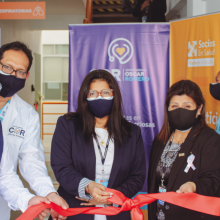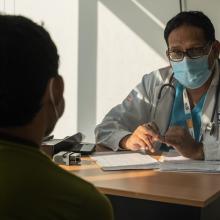During the latest edition of AIDS 2024, the world’s largest HIV and AIDS conference held in Munich (Germany) and attended by Partners In Health, the presentation of the results of the Phase III PURPOSE 1 trial were greeted with applause. It was no wonder: the study showed that lenacapavir has 100% efficacy in HIV preventionin cisgender women.
Lenacapavir is a U.S. Food and Drug Administration (FDA)-approved drug that belongs to the HIV-1 capsid inhibitor class. Applied with long-acting injectable (i.e., one application every six months as pre-exposure prophylaxis [PrEP]), it prevented 100 percent of HIV infections in the above population, whereas with daily oral PrEP, 1-2% of infections occurred.
“A couple of years ago, the World Health Organization (WHO) had already recommended the use of cabotegravir, another long-acting injectable but administered every 1-2 months, as a highly effective and acceptable PrEP option,” says Renato Errea, head of the HIV and STI Program at Socios En Salud. “However, its high cost was the main limitation for its implementation in low- and middle-income countries,” he adds.
Lenacapavir injectable prevented 100% of HIV infections in cisgender women, while with daily oral PrEP, 1-2% of infections occurred.
This scenario could change with lenacapavir. “Because of its proven effectiveness and its frequency of administration of only twice a year, this drug emerges as a great hope for preventing HIV acquisition worldwide,” says the specialist. Its safety and efficacy, along with other drugs, were tested in a double-blind, randomized study involving more than 5,300 women and adolescents aged 16 to 25 years in South Africa and Uganda.
The 2,134 women in the lenacapavir group reported no HIV infection. A finding that sparked great excitement at AIDS 2024, which was attended by scientists, health professionals, people living with HIV, funders, media and communities. “The community is requesting that the cost of the drug be accessible to the communities that need it most,” Errea says.
Also awaiting the results of the PURPOSE 2 study, which is “evaluating the effectiveness of lenacapavir in other populations, such as transgender populations and men who have sex with men.” “Should it show effectiveness also in these high-risk populations and be highly accessible to communities and countries with fewer resources, drugs such as lenacapavir can change the course of the fight against HIV,” he stresses.

Como parte de sus intervenciones, el Programa VIH e ITS, a través de su proyecto Juntrans, acude a eventos de la comunidad transgénero (como los campeonatos de vóley) para aprovechar en realizar tamizajes de VIH y tuberculosis.
Partners In Health at AIDS 2024
Partners In Health participated in AIDS 2024 to present the results of the acceptability of the oral self-test, conducted on 159 transgender women in Lima (where 66% were sex workers and about 50% had had unprotected sex in the past six months).
The research showed that 100% of participants found the test easy/very easy to use, and about 85% were confident in their results. “In addition, about 90% reported preferring the use of oral self-testing over capillary blood self-testing, and 85% would be willing to take an oral test again for free,” notes Errea.
The head of the HIV and STI Program at Socios En Salud highlights that “100% of the participants who obtained a positive test result managed to link to the Ministry of Health (MINSA) health centers for a confirmatory test.”
The head of the HIV and STI Program at Socios En Salud highlights that “100% of the participants who obtained a positive test result managed to link to the Ministry of Health (MINSA) health centers for a confirmatory test.
“In conclusion, the acceptability of the oral self-test and post-positive linkage were high, suggesting that the use of these tests is feasible and appropriate for this at-risk community in Lima,” he says.



